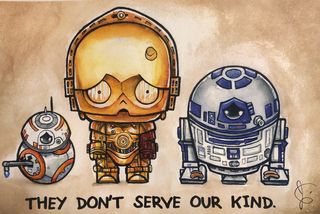Health
A Flag in the Window
Therapy is plagued by outdated notions of the practice.
Posted July 8, 2019

Be honest. When you think of therapy for adults, do you think of the following: pastel paintings, woven wall hangings (is there a therapist store where they get those things?), and an expressionless human sitting in an oversized chair nodding like a neutral-faced bobblehead while you tell your problems to the ceiling?
That makes sense.
Our conception of therapy has been shaped and honed over many years of incomplete and, at times, completely inaccurate, media representations.
There is an outdated conception that therapists must be a Tabula Rasa or a blank slate for their clients. In our experience, this isn’t a fit for all clients, and often is not a fit for clients who identify as existing outside the mainstream, such as those in the geek, secular, and LGBTQIA+ communities.
Clients who feel disenfranchised by the wellness and/or mental health communities need to be welcomed into therapy by familiar totems or symbols. A neutral setting—though well-intentioned—can serve the opposite of what it intends: making a prospective client feel alienated and unwelcome. If you’ve ever walked into one of these spaces and felt uncomfortable but didn’t know why, this might be part of it.
As an example of the power of totems, in our clinical experience, folks who identify as LGBTQIA+ often report that displaying symbols in support of queer culture, such as the rainbow-colored flag, results in an almost immediate sense of support and safety. Therapists sometimes make the assumption that displaying such symbols risks appropriation or worse, alienating other clients. There is even a common narrative in therapeutic spaces that by displaying a piece of art exemplifying their own cultural heritage, that they are limiting the space for their clients. We have found, however, that naming our own biases and backgrounds with clients can be a powerful way to invite them to share their own meaningful symbols and stories.
In our therapy spaces, we display art and action figures from the culture that speaks directly to us: geek or fandom culture. While we don’t exclusively treat those who identify with fandom culture, many of our clients skew in this direction and even those who do not find something silly and playful in such displays, like our SuperEmoFriends wall.
By featuring art, toys, and fidgets that are both artistic and silly, we are conveying the message that therapy need not be any one way. So keep this in mind the next time you’re entering a new therapy space. Therapy can be both challenging and fun, and while your therapist should never be your best friend (it’s just not HIPAA compliant nor is it in keeping with healthy therapeutic boundaries), they definitely can be your Jedi Master or your Gandalf the Grey.
References
Salvador, J. (2019). SuperEmoFriends: A decade of depression. El Sereno, CA: [author].


